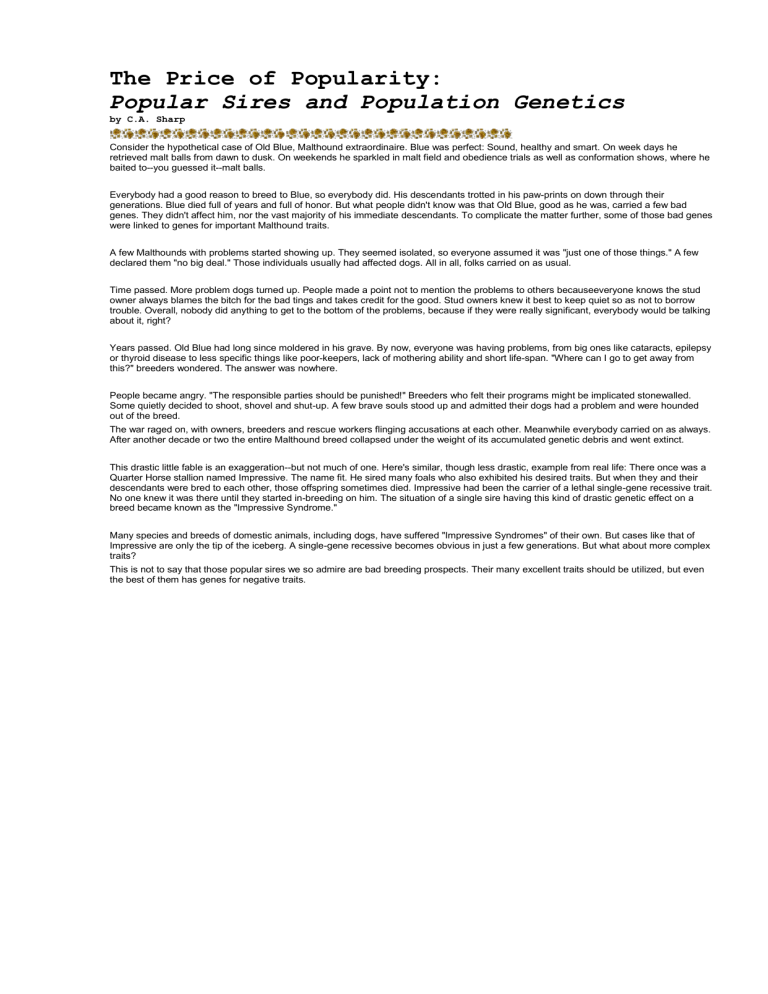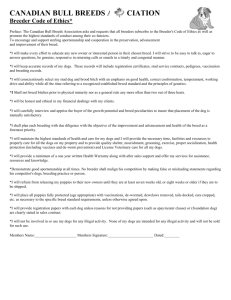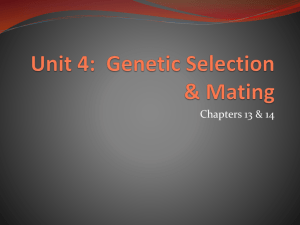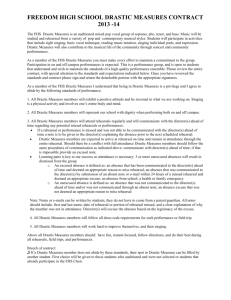The Price of Popularity

The Price of Popularity:
Popular Sires and Population Genetics
by C.A. Sharp
Consider the hypothetical case of Old Blue, Malthound extraordinaire. Blue was perfect: Sound, healthy and smart. On week days he retrieved malt balls from dawn to dusk. On weekends he sparkled in malt field and obedience trials as well as conformation shows, where he baited to--you guessed it--malt balls.
Everybody had a good reason to breed to Blue, so everybody did. His descendants trotted in his paw-prints on down through their generations. Blue died full of years and full of honor. But what people didn't know was that Old Blue, good as he was, carried a few bad genes. They didn't affect him, nor the vast majority of his immediate descendants. To complicate the matter further, some of those bad genes were linked to genes for important Malthound traits.
A few Malthounds with problems started showing up. They seemed isolated, so everyone assumed it was "just one of those things." A few declared them "no big deal." Those individuals usually had affected dogs. All in all, folks carried on as usual.
Time passed. More problem dogs turned up. People made a point not to mention the problems to others becauseeveryone knows the stud owner always blames the bitch for the bad tings and takes credit for the good. Stud owners knew it best to keep quiet so as not to borrow trouble. Overall, nobody did anything to get to the bottom of the problems, because if they were really significant, everybody would be talking about it, right?
Years passed. Old Blue had long since moldered in his grave. By now, everyone was having problems, from big ones like cataracts, epilepsy or thyroid disease to less specific things like poor-keepers, lack of mothering ability and short life-span. "Where can I go to get away from this?" breeders wondered. The answer was nowhere.
People became angry. "The responsible parties should be punished!" Breeders who felt their programs might be implicated stonewalled.
Some quietly decided to shoot, shovel and shut-up. A few brave souls stood up and admitted their dogs had a problem and were hounded out of the breed.
The war raged on, with owners, breeders and rescue workers flinging accusations at each other. Meanwhile everybody carried on as always.
After another decade or two the entire Malthound breed collapsed under the weight of its accumulated genetic debris and went extinct.
This drastic little fable is an exaggeration--but not much of one. Here's similar, though less drastic, example from real life: There once was a
Quarter Horse stallion named Impressive. The name fit. He sired many foals who also exhibited his desired traits. But when they and their descendants were bred to each other, those offspring sometimes died. Impressive had been the carrier of a lethal single-gene recessive trait.
No one knew it was there until they started in-breeding on him. The situation of a single sire having this kind of drastic genetic effect on a breed became known as the "Impressive Syndrome."
Many species and breeds of domestic animals, including dogs, have suffered "Impressive Syndromes" of their own. But cases like that of
Impressive are only the tip of the iceberg. A single-gene recessive becomes obvious in just a few generations. But what about more complex traits?
This is not to say that those popular sires we so admire are bad breeding prospects. Their many excellent traits should be utilized, but even the best of them has genes for negative traits.











